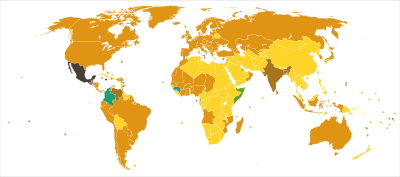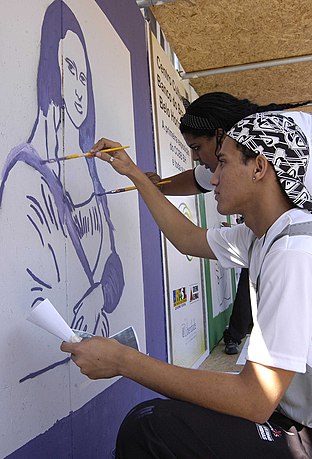Commons:Zasady prawa autorskiego
Pliki przesłane do Commons powinny być bezpłatne zarówno w kraju ich pochodzenia (zgodnie z definicją w Konwencji berneńskiej o ochronie dzieł literackich i artystycznych), jak i w Stanach Zjednoczonych Ameryki, a także w innych krajach, których dotyczy plik. Muszą mieć odpowiednią licencję właściciela praw autorskich lub przebywać w domenie publicznej.
Zasady prawa autorskiego zależne od tematu
- Osobny artykuł: Commons:Prawa autorskie według dziedziny.
Commons:Prawa autorskie według dziedziny łączy różne tematy i ma na celu odpowiedzieć na pytanie „Czy mogę przesłać fotografie / zdjęcia…?”
To jest OK:
- Generally, photos you have taken yourself of uncopyrightable subjects such as views; nature; yourself; and people who have given their consent for you to photograph them and for you to publish the photograph. (However, you should remember that uploads should be educational - Commons is not your private web space.)
- Photos taken by you, or scans or photocopies made by you of objects or designs whose copyright has expired (usually 70 years after the death of the author, but see Commons:Prawa autorskie według krajów for a country-by-country list).
- Mere mechanical scans or photocopies, made by somebody else, of an object or design old enough to be in the public domain (usually 70 years after the death of the author, but see Commons:Prawa autorskie według krajów for a country-by-country list). For scans of old images that may have been enhanced, see Commons:When to use the PD-scan tag/pl.
- Photographs, taken either by yourself or someone else, that are faithful reproductions of 2D public domain works of art. See Commons:When to use the PD-Art tag.
Other subjects may or may not be allowable - see headings at Commons:Prawa autorskie według dziedziny. If you want to have an answer to the question "Can I upload photographs/pictures from ...?", see the section at Commons:Prawa autorskie według dziedziny on Internet images. See also: Commons:Threshold of originality/pl.
Lista kontrolna
Załóżmy, że zrobiłeś zdjęcie swoim aparatem, zeskanowałeś je lub ściągnąłeś z internetu i chcesz umieścić na Wikimedia Commons. Skąd wiedzieć, czy umieszczając zdjęcie nie naruszasz licencji? Poniżej znajdziesz prosty schemat, który pomoże ci rozstrzygnąć ten problem. W razie wątpliwości zapoznaj się z umieszczonymi w dalszej części artykułu poradami dotyczącymi konkretnych krajów. Jeśli nadal będziesz miał wątpliwości, spytaj na Commons:Help desk lub na Commons:Village pump w twoim języku.
See Commons:Prawa autorskie według dziedziny for a more complete list.
Zdecydowanie OK:
Własne zdjęcia:
- Natury (las, niebo, itd.)
- Zwierząt (kot, pies, itd.)
- Owadów (mrówka, chrząszcz, itd.)
- Warzyw i owoców (jabłko, pomidor, itd.)
- Osób, które wyraziły na to zgodę
- Siebie samego (dopóki nie używasz tego jako prywatnej przestrzeni internetowej), but not pictures others took of you (these require the consent from whoever took the picture)
- Obiektów, które znajdują się w domenie publicznej zarówno Stanów Zjednoczonych jak i twojego kraju:
- Budynki zbudowane przez architekta, który co najmniej 70 (lepiej 100) lat temu (and first published before 1923)
- Dzieła sztuki stworzone przez artystę, który zmarł co najmniej 70 (lepiej 100) lat temu (and first published before 1923)
- Książki, których autor zmarł co najmniej 70 (lepiej 100) lat temu (and first published before 1923)
- Newspapers and Magazines published by an author who died 70+ (preferably 100+) years ago and first published before 1923
Własne skany z:
- Materiałów, których prawa autorskie wygasły zarówno w Stanach Zjednoczonych jak i w Twoim kraju.
- Pictures created entirely by you (based either on no earlier source or on a source which is in the public domain)
Materiałów z serwerów internetowych:
- Materiałów, których prawa autorskie wygasły zarówno w Stanach Zjednoczonych jak i w Twoim kraju jak i w kraju, w którym znajduje się serwer.
Sporne, mogą być lub nie być OK:
Wszystkie materiały podlegające prawom autorskim:
- Loga (jedynie bardzo proste wzory są OK), zobacz Commons:Nadawanie licencji section on Simple design.
- Zrzuty ekranów (zobacz Commons:Screenshots/pl)
Fotografii, rysunków, obrazów, skanów i innych reprodukcji:
- Samochodów (samochodów jednokolorowych bez żadnych reklam, rysunków itp. są OK)
- Produktów codziennego użytku (jedynie bardzo proste wzory są OK)
- Okładek książek (jedynie bardzo proste wzory są OK)
- Walut (zależy od prawa kraju; proszę zobacz Commons:Waluta)
- Budynków zbudowane przez architekta, który zmarł mniej niż 70 lat temu (lub ciągle żyje). Zobacz Commons:Wolność panoramy.
- Dzieła sztuki zainstalowane na stałe w miejscu publicznym, stworzone przez artystę, który zmarł mniej niż 70 lat temu (lub ciągle żyje). Zobacz Commons:Wolność panoramy.
- Wnętrza prywatnych domów, muzeów.
- Wizerunki znanych ludzi. Zobacz Commons:Fotografie rozpoznawalnych osób.
- Ludzi, którzy nie wyrazili na to zgody. Zobacz Commons:Fotografie rozpoznawalnych osób.
Zdecydowanie NIE OK
- Zdjęcia podlegające dozwolonemu użytkowi. Zobacz Commons:Dozwolony użytek.
- Fan art that closely resembles copyrighted material. Zobacz Commons:Fan art/pl.
- Fotografie, rysunki, skany i inne reprodukcje obiektów, które podlegają prawom autorskim (o ile nie należy ono do ciebie), na przykład:
- Figurki, statuetki, kostiumy i inne materiały podlegające prawom autorskim (zobacz Commons:Dzieła pochodne)
- Albumy, gry wideo, filmy oraz inne komercjalne produkty, w tym także plakaty, gazety oraz magazyny których prawa autorskie nie wygasły (okładki i wnętrza).
- Sounds of things that are copyrighted by someone other than you, like the following:
- Copyrighted radio stations (programs and commercials)
- Lyric songs created by an author whose copyright has not expired
Copyright rules by territory
- Osobny artykuł: Commons:Prawa autorskie według krajów.

Laws about copyright differ from country to country. Images uploaded to Commons, unless uploaded from the United States, involve the interaction of two or more copyright jurisdictions. The laws of individual countries differ especially in the following points:
- The time for which a copyright applies. In most countries, copyright expires no later than 70 years after the death of the author (p.m.a.). There may be special terms for recently published old material.
- Status of works of the government. In many (but not all) countries, documents published by the government for official use are in the public domain.
- Material applicable for copyright. In some jurisdictions, pictures of artistic work like architecture, sculptures, clothing etc. can not be used freely without the consent of the creator of the original artwork.
Almost all countries in the world are party to the Berne Convention for the Protection of Literary and Artistic Works (see here for the text). Following this convention, countries enforce copyrights from other countries, according to certain rules. One consequence of these rules is that we should always care about the laws of the country of origin of the work.
Dealing with uncertainty
When the date is unknown

Assume the most recent possible date considering the subject. The photo here shows Albert Einstein and his wife Elsa. Elsa died on December 20, 1936; Albert later on April 18, 1955. Therefore, it was taken before December 20, 1936.
When the place is unknown
Assume the most restrictive reasonably possible location considering the subject. In the Einstein photo here, it could be the United States, Germany, the Atlantic Ocean (assuming the Einstein couple was on board a ship) or any other country or location he reasonably could have gotten a photo taken in, but it would not likely be Nepal, for example.
When the photographer is unknown
Assume the most reasonable restrictive copyright barring evidence to the contrary. That is, unless the site or source itself asserts a freer set of rights (and you have good reason to believe they are not misapplying rights they do not have) assume the photographer retained all rights he legally could in his jurisdiction.
But the Berne Convention says that photographs are in the public domain 50 years after publication if the photographer is unknown. This applies unless a country has made a specific law.
Generally, for countries with copyright terms based on the death of the author, community consensus has found that it is safe to assume that the author died no more than 50 years after creating the work in cases where the author is unknown. This is encapsulated in the template {{PD-old-assumed}}.
Example

Assume that the author of the image on the right is unknown to us, but not unknown in the copyright sense. We know that the image represents the ship Borda, which was scrapped in 1891. The image could have been taken that year by a 20-year-old man, who could die of old age in his 90s; this brings us to 1960. Assuming the normal terms for "works" apply and a 70-year long copyright term pma, the image would be covered by copyright until the 2030s. If the work was truly anonymous, then the copyright probably did not exceed 1891 + 70 = 1961, which means it is free if it was published before 1928 (or free in USA for other reasons).
Caution, not being able to find an author does not mean that the work is anonymous. It can mean that we did not search long enough or at the right place.
Zobacz także: Commons:Zakres projektu/Zasada ostrożności.
Zobacz też
- Commons:Wikilivres – a similar site which is not operated by the Wikimedia Foundation but which allows for material in the Canadian public domain which is less restrictive than the United States
- Look at the Frequently Asked Questions.
- If you place
{{helpme}}on your talk page, a volunteer will visit you there as soon as possible!
- Join the #wikimedia-commons IRC channel for real-time chat. New to IRC? Click here to be connected instantly!
- Go to the Commons Help Desk.


